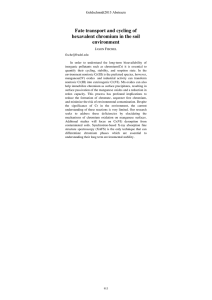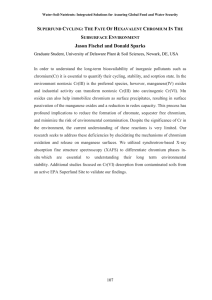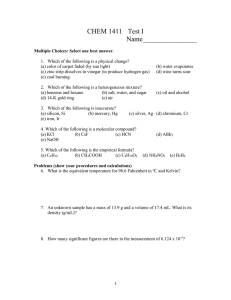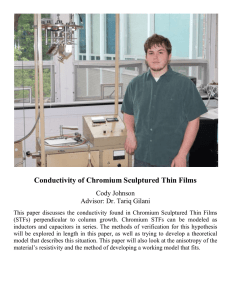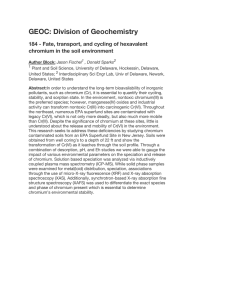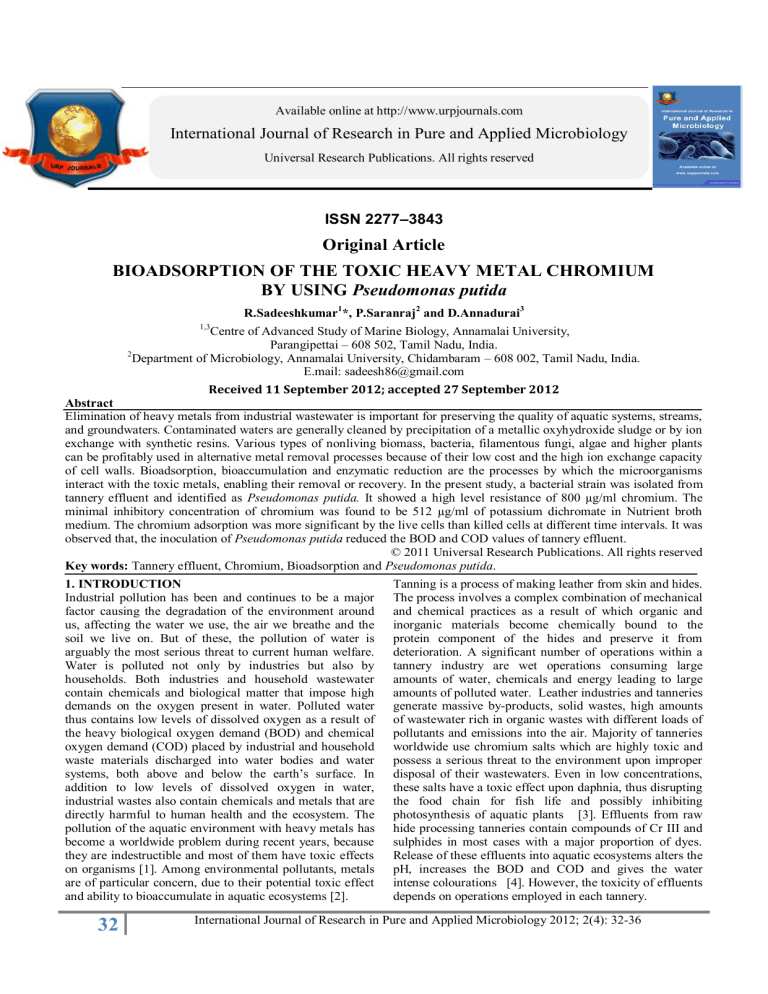
Available online at http://www.urpjournals.com
International Journal of Research in Pure and Applied Microbiology
Universal Research Publications. All rights reserved
ISSN 2277–3843
Original Article
BIOADSORPTION OF THE TOXIC HEAVY METAL CHROMIUM
BY USING Pseudomonas putida
R.Sadeeshkumar1*, P.Saranraj2 and D.Annadurai3
1,3
Centre of Advanced Study of Marine Biology, Annamalai University,
Parangipettai – 608 502, Tamil Nadu, India.
2
Department of Microbiology, Annamalai University, Chidambaram – 608 002, Tamil Nadu, India.
E.mail: sadeesh86@gmail.com
Received 11 September 2012; accepted 27 September 2012
Abstract
Elimination of heavy metals from industrial wastewater is important for preserving the quality of aquatic systems, streams,
and groundwaters. Contaminated waters are generally cleaned by precipitation of a metallic oxyhydroxide sludge or by ion
exchange with synthetic resins. Various types of nonliving biomass, bacteria, filamentous fungi, algae and higher plants
can be profitably used in alternative metal removal processes because of their low cost and the high ion exchange capacity
of cell walls. Bioadsorption, bioaccumulation and enzymatic reduction are the processes by which the microorganisms
interact with the toxic metals, enabling their removal or recovery. In the present study, a bacterial strain was isolated from
tannery effluent and identified as Pseudomonas putida. It showed a high level resistance of 800 µg/ml chromium. The
minimal inhibitory concentration of chromium was found to be 512 µg/ml of potassium dichromate in Nutrient broth
medium. The chromium adsorption was more significant by the live cells than killed cells at different time intervals. It was
observed that, the inoculation of Pseudomonas putida reduced the BOD and COD values of tannery effluent.
© 2011 Universal Research Publications. All rights reserved
Key words: Tannery effluent, Chromium, Bioadsorption and Pseudomonas putida.
1. INTRODUCTION
Industrial pollution has been and continues to be a major
factor causing the degradation of the environment around
us, affecting the water we use, the air we breathe and the
soil we live on. But of these, the pollution of water is
arguably the most serious threat to current human welfare.
Water is polluted not only by industries but also by
households. Both industries and household wastewater
contain chemicals and biological matter that impose high
demands on the oxygen present in water. Polluted water
thus contains low levels of dissolved oxygen as a result of
the heavy biological oxygen demand (BOD) and chemical
oxygen demand (COD) placed by industrial and household
waste materials discharged into water bodies and water
systems, both above and below the earth’s surface. In
addition to low levels of dissolved oxygen in water,
industrial wastes also contain chemicals and metals that are
directly harmful to human health and the ecosystem. The
pollution of the aquatic environment with heavy metals has
become a worldwide problem during recent years, because
they are indestructible and most of them have toxic effects
on organisms [1]. Among environmental pollutants, metals
are of particular concern, due to their potential toxic effect
and ability to bioaccumulate in aquatic ecosystems [2].
32
Tanning is a process of making leather from skin and hides.
The process involves a complex combination of mechanical
and chemical practices as a result of which organic and
inorganic materials become chemically bound to the
protein component of the hides and preserve it from
deterioration. A significant number of operations within a
tannery industry are wet operations consuming large
amounts of water, chemicals and energy leading to large
amounts of polluted water. Leather industries and tanneries
generate massive by-products, solid wastes, high amounts
of wastewater rich in organic wastes with different loads of
pollutants and emissions into the air. Majority of tanneries
worldwide use chromium salts which are highly toxic and
possess a serious threat to the environment upon improper
disposal of their wastewaters. Even in low concentrations,
these salts have a toxic effect upon daphnia, thus disrupting
the food chain for fish life and possibly inhibiting
photosynthesis of aquatic plants [3]. Effluents from raw
hide processing tanneries contain compounds of Cr III and
sulphides in most cases with a major proportion of dyes.
Release of these effluents into aquatic ecosystems alters the
pH, increases the BOD and COD and gives the water
intense colourations [4]. However, the toxicity of effluents
depends on operations employed in each tannery.
International Journal of Research in Pure and Applied Microbiology 2012; 2(4): 32-36
Chromium, a priority pollutant is well known for its
mutagenicity, carcinogenicity and teratogenicity in humans,
experimental animals and plants. Extensive use of
chromium in industries such as leather tanning, stainlesssteel production, electroplating and wood preservatives
have resulted in chromium contaminated soil and ground
water at production sites [5] which pose a serious threat to
human health. The hexavalent chromium compounds are
comparatively more toxic than trivalent chromium
compounds due to their higher solubility in water, rapid
permeability through biological membranes and subsequent
interaction with intracellular proteins and nucleic acids [6].
A maximum acceptable concentration of 0.05 mg/l for
hexavalent chromium in drinking water has been
established on basis of health considerations. However, its
high toxicity, mutagenicity and carcinogenicity renders it
hazardous even at very low concentration.
In general, treatment of effluents includes physiochemical
methods such as filtration, specific coagulation, use of
activated carbon and chemical flocculation [7].
Conventional treatment of tannery effluents for the purpose
of detoxification requires application of physical and
chemical methods which involves the chrome precipitation
and sulphide treatment. Due to associated problems in these
treatments such as cost and intense experimental set-up [8,
9], biological treatment methods using various bacteria and
fungi have been widely studies.
Recent developments in biology have provided new tools
and approaches for monitoring the environment and
engineering organisms with the capacity to degrade
environmental pollutants. Different types of organisms can
be bioremediation agents. Considering the enormous
biodiversity and biological wealth in this country, basic
research and modern biology, product oriented research for
new generation of vaccines, diagnostics, recombinant
products and other bio products specially the eco-friendly
technologies would be the priority agenda for future. The
present study is focused on isolation, identification of
chromium resistant Pseudomonas putida and its ability to
remove chromium contaminants in tannery effluents.
2. MATERIALS AND METHODS
2.1. Sample collection
Tannery effluents were collected from leather industry at
Aambur in Vellore district. The sample was collected after
the primary treatment in Leather industry.
2.2. Isolation and identification of Pseudomonas putida
from Tannery effluent
The tannery effluent sample was taken and diluted in water
and was isolated by Serial dilution technique followed by
Spread plate method. The isolated colony was sub-cultured
in Minimal salt agar medium supplemented with
hexavalent chromium 100µg/ml (hexavalent chromium was
supplemented in the form of potassium dichromate) and
also in Nutrient agar with Potassium dichromate medium
50mg/100ml, and incubated at 37°C for 2 days.
Identification of the bacterial isolates was carried out by the
routine bacteriological methods i.e., By the colony
morphology, preliminary tests like Gram staining, motility,
plating on selective medias and performing biochemical
tests.
33
2.3. Evaluation of chromium tolerance
The isolated bacterium (Pseudomonas putida) was tested
for their resistance to chromate both by Agar dilution
method and Broth dilution method.
2.3.1. Agar dilution method
The test organism inoculating into Nutrient broth and
incubated at 37°C in a shaker incubator at 150 rpm till the
concentration of the test organisms matched with 0.5
McFarland standards. In this method, Pseudomonas putida
was aseptically streaked into freshly prepared Nutrient agar
plates amended with hexavalent chromium as dichromate at
various concentrations ranging from 100 – 1500 µg/ml.
Plates were then incubated at 37°C for
24 hours.
2.3.2. Broth dilution method
The test organism was inoculated into Nutrient broth and
incubated at 37°C in a shaker incubator at 150 rpm till the
concentration of the test organisms matched with 0.5
McFarland standard. A stock solution of chromium was
prepared (50 mg/100ml). Two fold dilutions of this solution
were prepared in Nutrient broth medium. A standard
suspension of Pseudomonas putida was inoculated onto the
medium with one control chromium solution free medium.
The inoculated medium was then incubated at 37°C for 24
hours.
2.4. Bioadsorption studies
2.4.1. Estimation of standard chromium: (Diphenyl
carbazide method)
A standard curve for the reaction between chromium and
its binding dye, 1,5 – diphenyl carbazide was added to
determine the chromium concentration. The diphenyl
carbazide forms a pink complex with hexavalent chromium
but not with trivalent chromium. [10]. 50 mg of potassium
dichromate was dissolved in 100 ml of sterile distilled
water, in standard flask. From this standard, 0.02, 0.04,
0.06, 0.08 and 0.1 ml of chromium was added into different
tubes, then the volume was made upto 2 ml. 2 ml of
distilled water was taken as blank. To all the above tubes,
0.04 µl of diphenyl carbazide and one drop of sulphuric
acid were added and the residual hexavalent chromium
content was determined at 540nm in colorimeter.
2.4.2. Chromium uptake
24 hours old culture of Pseudomonas putida was prepared
in Nutrient broth. To 50 ml of Nutrient broth, 50 µg/ml of
potassium dichromate was added and sterilized. Similarly
another set was prepared. To the first set, 10 ml of
overnight broth culture i.e., live cells were added. To the
second set, 10 ml of 24 hours culture was autoclaved at
121ºC for 15 minutes i.e., killed cells was added. From
above, 10 ml of samples were removed at different time
intervals and centrifuged at 8000 rpm for 20 minutes. Then
the pellet obtained was homogenized in 2 ml of phosphate
buffer. To this 0.04 µl of diphenyl carbazide and one drop
of sulphuric acid was added to the homogenate. Chromium
uptake was estimated using diphenyl carbazide method at
540 nm in colorimeter.
2.4.3. Chromium reduction
Reduction of chromium was determined by growing the
Pseudomonas putida in Nutrient broth supplemented with
hexavalent chromium as dichromate at a concentration of
50 µg/ml. Cells were grown on a shaker incubator (150
International Journal of Research in Pure and Applied Microbiology 2012; 2(4): 32-36
rpm) for 24 hours. Supernatant obtained after centrifugation
was used for chromate reductase assay. Chromate reductase
activity was estimated as the decrease in chromium
concentration with time using hexavalent chromium
specific colorimetric reagent 1,5-diphenyl carbazide (DPC)
0.5% (vol/vol) prepared in acetone. To 1 ml of supernatant,
1 ml of phosphate buffer (pH 7.2) with chromium was
added and incubated for 1 hour. After incubation, 1 drop of
0.1 M sulphuric acid and 0.04 µl of 1,5 diphenyl carbazide
was added. The readings were taken in colorimeter
(540nm).
2.5. Physico-chemical analysis of tannery effluent
Physico-chemical characteristics of tannery effluent was
analyzed before and after treatment.
3. RESULTS AND DISCUSSION
Hexavalent chromium [Cr(VI)] has many industrial
applications and often causes environmental contamination
in marine and freshwater sediments from urban and
industrial discharges. Chromate is a strong oxidizing agent
that is reduced intracellularly to Cr 5+ and reacts with
nucleic acids and other cell components to produce
mutagenic and carcinogenic effects on biological systems
[11]. Although reduction to Cr5+ is responsible for chromate
toxicity, further reduction to trivalent chromium leads to
the formation of stable, less soluble, and less toxic Cr (III).
Reduction of Cr (VI) to Cr (III) is therefore a potentially
useful process for remediation of Cr (VI)-affected
environments [12]. Bioreduction of Cr (VI) can occur
directly as a result of microbial metabolism (enzymatic) or
indirectly, mediated by a bacterial metabolite. A number of
chromium-resistant microorganisms have been reported,
including Pseudomonas spp. [13], Microbacterium [14],
Desulfovibrio, Enterobacter spp., Escherichia coli,
Shewanella alga [15], Bacillus sp. [16], and several other
bacterial isolates [17]. However, most of them have been
isolated from tannery sludge, industrial sewage,
evaporation ponds, or discharge water, or were purchased
from culture collections.
With the increasing demand for leather and leather
products, both for indigenous use as well as for export,
large number of vegetable and chrome tanneries have
mushroomed in India, especially in states like Tamil Nadu,
Uttar Pradesh and West Bengal. Tannery wastewater is
characterized by its strong colour, high COD, high BOD,
and TDS. The levels of pollutants in tannery wastewater
also vary depending upon the process adopted in leather
making. The unplanned manner in which these units have
come up forces to think about their disposal of liquid
effluents. The quality of discharged waters from tanneries
is far from the desired level of acceptance into waterways.
As a result, the tanneries are forced to construct a Common
Effluent Treatment Plant (CETP). Tamil Nadu Pollution
Control Board accorded permission to resume the operation
of those tanneries, which put up full-fledged Effluent
Treatment Plant (ETP) or CETP. The treatment of tannery
effluent depends on the efficiency with which the CETP
functions. Hence, the continuous evaluation is a
prerequisite for up keeping of efficiency with which the
CETP functions [18].
The chromium resistant bacterium from tannery effluent
34
was identified by preliminary tests, cultivating on selective
media and standard biochemical tests. Based on the
conventional biochemical tests, the organism was identified
as Pseudomonas aeruginosa. The isolation of chromium
resistant bacteria from tannery effluents and identified as
Brevibacterium sp. and Brucella sp. respectively.
In Agar dilution method, the bacterial isolate
(Pseudomonas putida) was resistant to hexavalent
chromium level at 800 µg/ml. Above 800 µg/ml of
chromium, the growth was inhibited. In Broth dilution
method, the bacterial isolate (Pseudomonas putida) was
resistant to hexavalent chromium level at 512 µg/ml.
Growth was inhibited at above 512 µg/ml of hexavalent
chromium level. Shahida Hasnain and Indu Shekhar Thakur
[19] found that Brevibacterium sp. showed high level –
resistance of chromium upto 40 mg/ml by Agar dilution
method. Megharaj and Naidu [20] examined that Bacillus
sp. tolerated hexavalent chromium at 100 mg/ml on a
minimal medium supplemented with 0.5% glucose.
Table-1: Estimation of standard chromium by Diphenyl
carbazide method
Concentration of chromium
Optical density
(in µg)
(in nm)
10
0.30
20
0.60
30
0.90
40
1.20
50
1.50
In this study, the standard chromium was estimated by
Diphenyl carbazide method and the results were showed in
Table – 1. Bioadsorption studies were done to test the
ability of cells (both live and dead cells) to accumulate
chromium at different time intervals 15 minutes, 5 and 24
hours. The results were shown in Table-2. The living cells
accumulated 22, 30 and 38 µg/ml of chromium and the
killed cells accumulated 8, 10 and 10 µg/ml of chromium.
The rate of chromium accumulation was rapid. It showed
that the living cells exhibited better chromium uptake
compared to heat killed cells. The ability of Pseudomonas
putida to reduce chromium at different time intervals 15, 30
and 60 minutes was 19, 18 and 18 µg/ml of chromium.
Pseudomonas putida has not shown significant chromium
reduction in the supernatants.
Kader et al. [21] showed that the rate of chromium
accumulation by active cells was also faster compared to
chromium reduction. The maximum amount of chromium
accumulated by consortia was 6.4 mg/L and the reduction
of chromium was 1.8 mg/L. Shahida Hasnain and
Indu Shekhar Thakur [22] found that Brevibacterium sp.
living cells pellet showed higher chromium uptake than
killed cells pellet when time intervals increased.
Table – 2: Estimation of Chromium uptake
Time (in hours)
15 minutes
5
24
Chromium uptake in whole cells (µg)
Live pellet
Killed pellet
22
8
30
10
38
10
The ability of Pseudomonas putida to reduce chromium at
different time intervals 15, 30 and 60 minutes was 19, 18
International Journal of Research in Pure and Applied Microbiology 2012; 2(4): 32-36
Table-3: Estimation of chromium reduction
Time
Reduction of chromium level in
(Min)
supernatant (µg)
15
19
30
18
60
18
and 18 µg/ml of chromium and the chromium reduction is
showed in Table -3. Pseudomonas putida has not shown
significant chromium reduction in the supernatants. Kader
et al. [23] showed that the rate of chromium accumulation
by active cells was also faster compared to chromium
reduction. The maximum amount of chromium
accumulated by consortia was 6.4 mg/L and the reduction
of chromium was 1.8 mg/L. Shahida Hasnain and
Indu Shekhar Thakur [24] found that Brevibacterium sp.
living cells pellet showed higher chromium uptake than
killed cells pellet when time intervals increased.
Physico-chemical analysis of tannery effluent was analyzed
before and after treatment. After the inoculation of
Pseudomonas putida in tannery effluents, the pH of the
tannery effluents was brought down from 11.6 to7.The
BOD mg/lit of the tannery effluents was reduced from 8000
to 6400. The COD mg/lit of the tannery effluents was
reduced from 5000 to 2500. Chromium content level was
reduced from 38 µg- 25 µg/ml. Duangporn Kantachote et
al. [25] identified the reduction of biological oxygen
demand in tannery effluents from 4967 mg/L to 1010
mg/ml after inoculation of Rhodopseudomonas blastica. He
also found the reduction of chemical oxygen demand from
7328 mg/L to 3371 mg/L in tannery effluents.
Saranraj et al. [26] isolated a bacterial strain from tannery
effluent and identified as Enterococcus casseliflavus. It
showed a high level resistance of 800 µg/ml chromium.
The minimal inhibitory concentration of chromium was
found to be 512 µg/ml of potassium dichromate in Nutrient
broth medium. The chromium adsorption was more
significant by the live cells than killed cells at different
time intervals. It was observed that, the inoculation of
Enterococcus casseliflavus reduced the BOD and COD
values of tannery effluent. The maximum adsorption of
chromium was at a temperature of 35ºC to 45ºC and at a pH
of 7.0 to 7.5.
4. CONCLUSION
The chromium uptake from tannery effluents was
significantly found in live pellet cells than killed pellet cells
of Pseudomonas putida. Irrespective of the pH of the
tannery effluent, Pseudomonas putida has shown
significant chromium adsorption by bringing down the pH
of tannery effluent to neutral pH 7. Application of
traditional wastewater treatment requires enormous cost
and continuous input of chemicals which becomes
uneconomical and causes further environmental damage.
Hence easy effective economical and ecofriendly
techniques such as utilization of bacteria can be applied for
fine tuning of wastewater treatment.
5. REFERENCE
1) MacFarlane, G. B. Ajayi, S.O., Osibanjo, O. 1980. The
state of environment in Nig. Pollution studies of textile
industries in Nigeria. Monogra, 1: 76-86.
35
2) Burchettt, M. D. 2000. Cellular distribution of Cu, Pb,
and Zn in the Grey Mangrove Avicemnia marina
(Forsk.). Vierh Aquatic Botanic, 68: 45–59.
3) Censi, P., Spoto, S. E., Saiano, F., Sprovieri, M.,
Mazzola, S., Nardone, G., Di Geronimo, S. I., Punturo,
R., Ottonello, D. 2006. Heavy metals in coastal water
systems. A case study from the Northwestern Gulf of
Thailand. Chemosphere, 64: 1167–1176.
4) Bosnic, M., Buljan, J., Daniels, R.P. 2000. Pollutants
in tannery effluents. United Nations Industrial
Development Organization: 1-26.
5) Turick and Carmiol. 1996. Isolation of Cr VI reducing
anaerobes from Cr contaminated and non contaminated
areas. Applied Biotechnology and Microbiology, 44(5):
683-688.
6) Sultan and Hasnain. 2005. Isolation of hexavalent
chromium-reducing Cr-tolerant facultative anaerobes
from tannery effluent. Journal of General Applied
Microbiology, 47: 307-312.
7) Olukanni, O.D., Osuntoki, A.A and Gbenle, G.O.
2006. Textile effluent biodegradation potentials of
textile effluent-adapted and non-adapted bacteria.
African Journal of Biotechnology, 5 (20): 1980-1984.
8) Do, T., Shen, J., Cawood, G., Jeckins, R. 2002.
Biotreatment of textile effluent using Pseudomonas
spp. Immobilized on polymer supports. In: Advances in
biotreatment for textile processing. (Hardin, I.R; Akin
D.E & Wilson J.S, eds). University of Georgia Press.
9) Maier, J., Kandelbauer, A., Erlacher, A., CavacoPaulo, A., Gubits, G.M. 2004. A new alkalithermostable azoreductase from bacillus sp. Strain SF.
Applied Environmental Microbiology, 70:837-844.
10) Young Hak, Kwak and Han Bok Kim. 2003. Vibrio
harveyi is also a chromate reductase. Applied
Environmental and Microbiology, 69: 4390-4395.
11) McLean, J and T.J. Beveridge. 2001. Chromate
reduction by a pseudomonad isolated from a site
contaminated with chromated copper arsenate. Applied
Environmental Microbiology, 67:1076–1084.
12) Michel, C., M. Brugma, C. Aubert, A. Bernadac, and
M. Bruschi. 2001. Enzymatic reduction of chromate:
Comparative studies using sulfate-reducing bacteria.
Applied Microbiology and Biotechnology, 55:95–100.
13) Alvarez, A.H., R. Moreno-Sanchez, and C. Cervantes.
1999. Chromate efflux by means of the chrA chromate
resistance protein from Pseudomonas aeruginosa.
Journal of Bacteriology, 181:7398–7400.
14) Pattanapipitpaisal, P., N.L. Brown, and L.F. Macaskie.
2001. Chromate reduction and 16S rRNA
identification of bacteria isolated from a Cr (VI)contaminated site. Applied Microbiology and
Biotechnology, 57:257–261
15) Guha, H., K. Jayachandran, and F. Maurrasse. 2001.
Kinetics of chromium (VI) reduction by a type strain
Shewanella alga under different growth conditions.
Environmental Pollution, 115: 209 – 218.
16) Campos, J., M. Martinez-Pacheco, and C. Cervantes.
1995. Hexavalent-chromium reduction by a chromateresistant Bacillus sp. strain. Antonie Van Leeuwenhoek,
68: 203–208.
International Journal of Research in Pure and Applied Microbiology 2012; 2(4): 32-36
17) Holman, H.-Y.N., D.L. Perry, M.C. Martin, G.
1999. Real-time characterization of biogeochemical
reduction of Cr (VI) on basalt surfaces by SR-FTIR
imaging. Geomicrobiology Journal, 16: 307–323.
18) Prasad, B.G.S and B.V.S Gurunatha Rao. 1981.
Studies on the treatment and disposal of tannery
wastewater, Part 1, Leather Science, 28, 221.
19) Shahida Hasnain and Indu Shekhar Thakur. 2007.
Evaluation of biosorption potency of Acinetobacter sp.
for removal of hexavalent chromium from tannery
effluent. Journal of Earth and Environmental Science,
18(5): 637-646..
20) Megharaj and Naidu. 2003. Toxicity of Cr VI and its
reduction by bacteria isolated from soil contaminated
with tannery waste. Journal of Earth and
Environmental Science, 47(1): 51-4.
21) Kader, P. Sannasi, O. Othman, B.S. Ismail and S.
Salmijah. 2007. Removal of Cr (VI) from Aqueous
Solutions by Growing and Non-growing Populations
of Environmental Bacterial Consortia. Global Journal
of Environmental Research, 1(1): 12-17.
22) Shahida Hasnain and Indu Shekhar Thakur. 2007.
Evaluation of biosorption potency of Acinetobacter sp.
23)
24)
25)
26)
Lamble, W.R. McKinney, and J.C. Hunter-Cevera.
for removal of hexavalent chromium from tannery
effluent. Journal of Earth and Environmental Science,
18(5): 637-646.
Kader, P. Sannasi, O. Othman, B.S. Ismail and S.
Salmijah. 2007. Removal of Cr(VI) from Aqueous
Solutions by Growing and Non-growing Populations
of Environmental Bacterial Consortia. Global Journal
of Environmental Research, 1(1): 12-17.
Shahida Hasnain and Indu Shekhar Thakur. 2007.
Evaluation of biosorption potency of Acinetobacter sp.
for removal of hexavalent chromium from tannery
effluent. Journal of Earth and Environmental Science,
18(5): 637-646..
Duangporn Kantachote, Salwa Torpee, Kamontam
Umsakul. 2005. The potential use anoxygenic
phototrophic bacteria for treating latex rubber sheet
wastewater. Electronic Journal of Biotechnology, 8(3):
11 – 17.
Saranraj.P., Stella.D., Reetha.D and Mythili.K. 2010.
Bioadsorption of chromium resistant Enterococcus
casseliflavus isolated from tannery effluent. Journal of
Ecobiotechnology, 2 (7): 17 – 22.
Source of support: Nil; Conflict of interest: None declared
36
International Journal of Research in Pure and Applied Microbiology 2012; 2(4): 32-36

